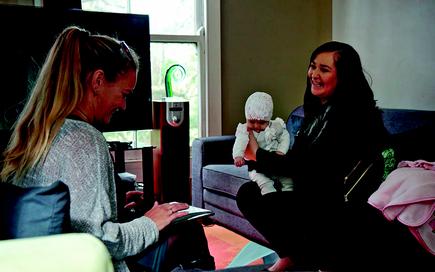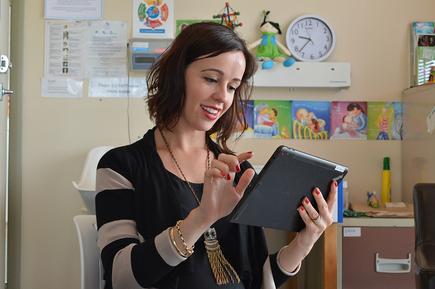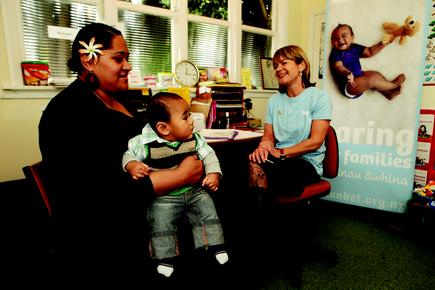Lois van Waardenberg: 1000 days to make a difference
- 08 September, 2016 07:00

Photo by Divina Paredes
It’s a challenge modernising an organisation steeped in tradition while remaining true to its soul!
Lois van Waardenberg vividly recalls the first time she encountered Plunket.
She was then 12 and the oldest of seven children. Her mother got hepatitis following the birth of her youngest brother and Plunket helped her mother a great deal at the time.
When she gave birth to her now two adult children, van Waardenberg was then living in London, and thus, did not have the support her mother got from Plunket.
But she is glad that years later, she is able to give back to the organisation that stood by her family at a critical time.
Van Waardenberg joined Plunket in August last year as its first chief information officer. Five months earlier, she left Z Energy as head of business information and technology services at the company.
More than three months ago, she was asked to take on the chief operating officer role. Roy Goldsmith, formerly with Inland Revenue Department and Bank of New Zealand, is now acting CIO.
Plunket, also known as the Royal New Zealand Plunket Society, is the largest provider of free support services for the development, health and wellbeing of children under five and its staff sees more than 90 per cent of newborns in the country each year. The not for profit, supported by government contracts and philanthropic donations was founded in 1907 in Dunedin by child health visionary, Sir Frederic Truby King.

With the use of analytics, we need to understand where our social investment can be put to get the best returns. What interventions make the most difference?
Van Waardenberg’s current role is a combination of strategic and practical responsibilities.
She smiles when asked what is a typical workday for her.
“There isn’t one, really, every day is very varied.”
What inspires her, she says, is the new vision of the organisation: “In the first 1000 days, we will make the difference of a lifetime in a person.”
“We used to have the vision of ‘the best start for every child’.”
“That is a good thing, but the new vision is much more action focused,” says van Waardenberg. “It supports the scope, the width of what we do. We are not just weighing babies.”
There are three main strands or goals to this vision, she says.
Healthy tamariki is about making sure every child/tamariki has the opportunity to be as healthy and as well as they can be. Plunket is the main provider of the Ministry of Health’s Well Child/Tamariki Ora (WCTO) service for 0-5 year olds.
The second is confident whānau, or building the confidence and knowledge of whānau and families across New Zealand. It is about confident parenting as families have such an impact on the health and outcomes of the child, explains van Waardenberg.
The third is around connected communities, or making sure no family/whānau is left isolated, disconnected or unable to cope.
Van Waardenberg says Plunket’s internal governance is under review, with the goal of fairer health outcomes across New Zealand. “The question we ask ourselves is – how do we leverage the access, trust, reach and resources of a national organisation whilst being deeply connected within local communities?”
“Our services don’t stand still,” she says. This is an environment that makes them no different from commercial enterprises, whose users demand 24x7 access to their systems.
We run a health service so quality is very critical, she says. “We want to know what the communities really want and need.”
Next: Hard evidence and human-centred design
Page Break
Human-centred design
She says Plunket has started a project assessing and designing the services across the organisation using a “human-centred design” approach.
“We understand the way we developed over time is quite organic,” she explains. “Like many organisations, our services internally are not connected as they should be and need to be more customer centric.”
The organisation is interviewing families (its target “customers”) and staff in order to transform how it operates, she says of the empathy research that was started a month ago.
“You will find that many public services in government and not for profits are using this approach, which means deeply understanding the experience of the people that you service,” she states.

The research is being undertaken with ThinkPlace, which has worked with the Ministry of Social Development and other government agencies on similar research on human-centred design.
“We expect to have completed this work by June next year, resulting in a detailed blueprint and roadmap of how we join up our services and create the services core of the Plunket of the future,” says van Waardenberg.
The research team is interviewing 30 families selected across the regions, as well as 15 staff. “These are very deep interviews and we have required approval from the ethics committee in order to ascertain we are not just wasting people’s time in our own interest.”
The core design team undertaking the research and the related insight mining, concept generation and prototyping and testing includes Plunket nurses and other staff from across the organisation.
“The nurses will continue to work half-time in their local communities, which is a great way to percolate what we’re doing out in the workforce,” says van Waardenberg.
“We need to do this,” she says. “We are a well-known brand. We have enormous trust and reach, but we need to modernise, we need to move to a flexible future.”
“We are wanting to build a way of working that meets customers’ wants and needs, and constantly adapts to our changing environment. Anyone who has ever run a services business, let alone a large national organisation, understands what a great challenge that is.”
Before joining Plunket, van Waardenberg had worked in the commercial and government sectors in the UK, Australia and New Zealand. She has been CEO of Transformation Analytics, and held a range of executive, business, and consulting roles at Z Energy, HP, RHE, Suncorp Group, Optimation, the UK Post Office, and Promina Group, amongst others.
Van Waardenberg had trained as a classical pianist and worked as a music teacher and performer. When she decided to go back to the commercial sector, she took a master’s in computer science and also completed a degree in law.

Our services don't stand still
“My technology experience is useful because I understand what is underneath the surface - how to design business processes and information structures.”
Her range of “softer skills” including her music teaching background, on the other hand, (she seriously considered midwifery as a career after giving birth to her first child) allows for the empathy she has for the families Plunket works with.
“It does feel like an amazing confluence of such a variety of experience,” she says. “I am now in a place where I can use the full range of my experience and bring it to bear on a set of services to make a difference for multiple generations of New Zealanders.”
The organisation got its name from one of its initial patrons, Victoria Alexandrina Plunket, who was a mother of eight and wife of then Governor of New Zealand, William Plunket.
Van Waardenberg noted how the Plunket founder, Dr Frederic Truby King, was concerned about the high infant mortality rate in New Zealand.
He rallied the community to set up and support hospitals to provide a safe and caring environment for new and expectant mothers and their babies. The hospitals and the health campaign launched simultaneously, were credited for drastically cutting the infant mortality rates at that time.
Plunket as a connector and integrator
Van Waardenberg says then and now, Plunket works in collaboration with the community. “It is a connector, an integrator.”
“Plunket is really visible and valuable,” she says. “It is a strong brand. We are working to revitalise our brand, so as to remain at the heart of the next generation of New Zealanders. It’s a challenge modernising an organisation steeped in tradition while remaining true to its soul!”
“We will use good technology to show how we make a difference,” she says. “We need both hard evidence and anecdotal stories to show what we are doing.”
This year, she says Plunket will finish the national rollout of a Microsoft cloud based system called the ePHR or Electronic Plunket Health Record. This provides the core for the system that is linked to the tablets the Plunket nurses carry when they visit the families.

These are tablets running an app that the nurses use to do their WCTO assessments of children. These tablets are fitted with contamination-proof hard cases.
We need to extend that collection of information to our other services, she says. She sees further use of technologies, from data analytics to collaboration.
A mother who gives birth to her first child may be well and excited when the Plunket nurse comes to visit. A couple of weeks later, the baby may get sick and the mother needs to talk to someone from Plunket.
At present, it runs a 24 hour a day, seven day a week 0800 PlunketLine. She is looking a time when these interactions could be augmented with video calls.

We will use good technology to show how we make a difference...We need both hard evidence and anecdotal stories to show what we are doing.
ACC, meanwhile, has forged a partnership with Plunket because of the organisation’s reach into people’s homes. Accident Compensation Corporation (ACC) is working with Plunket to manage a series of injury prevention and child safety programmes.
When we go into a home, we are able to assess where we can help beyond the basic developmental needs of the child, says van Waardenberg.
“We have all sorts of opportunities based on the fact that we are trusted to deliver the Well Child service,” she says,on helping families and their young children.
She says at law school, one of the requirements for their study of criminal law were to read through “terrible cases” of child abuse.
''Those cases had a huge impact on me, and they still do,” she says, more so when she learned of more recent cases.
“It feels very close to home now because the people I work with and the way I lead can make a difference to a child surviving, and not surviving.”
And this, she says, links back to the ongoing project on the services design research that they are doing.
“I want the services to be designed to get as close as we can to acting where it matters most,” she says.
With the use of analytics, “we need to understand where our social investment can be put to get the best returns. What interventions make the most difference?”
So from her experience, is the CIO post a springboard for chief operating officer role?
“It is, absolutely, yes,” she says. “The CIO role can be a springboard for anything you want.”
“You just sometimes have to wait for the right moment.”

Send news tips and comments to divina_paredes@idg.co.nz
Follow Divina Paredes on Twitter: @divinap
Follow CIO New Zealand on Twitter:@cio_nz
Sign up for CIO newsletters for regular updates on CIO news, views and events.

